Apollo RT6, the 6th Generation Robotaxi by Apollo, Unveiled at Baidu World Conference 2022
Authors: Mr. Yu & Xiao Pangzi
Today, Baidu World Conference 2022 has been dominating the news feed. The sixth-generation Robotaxi, Apollo RT6, goes into mass production and was unveiled at the conference.
The automobile and transportation industry has taken the lead position in this year’s Baidu World Conference. As a result, automobile enthusiasts were eagerly awaiting this year’s main attraction.

If it wasn’t for the strong impact of Jidu Auto’s ROBO-01 concept car rolling out recently, expectations were raised that there would be an unveiling for Baidu’s automobile robot.
Standing besides Apollo RT6 in the grand hall, CCTV anchor Sa Beining and Baidu Group’s Senior Vice President and General Manager of Intelligent Driving Business Unit, Li Zhenyu once again attracted the public’s attention. I couldn’t help but exclaim: “Finally, it looks like a car!”. There was no “burden pack” of various equipment on the roof, nor was it too square and nerdy to invoke the well-known phrase “Autobots, transform and roll out!” in Optimus Prime’s voice.
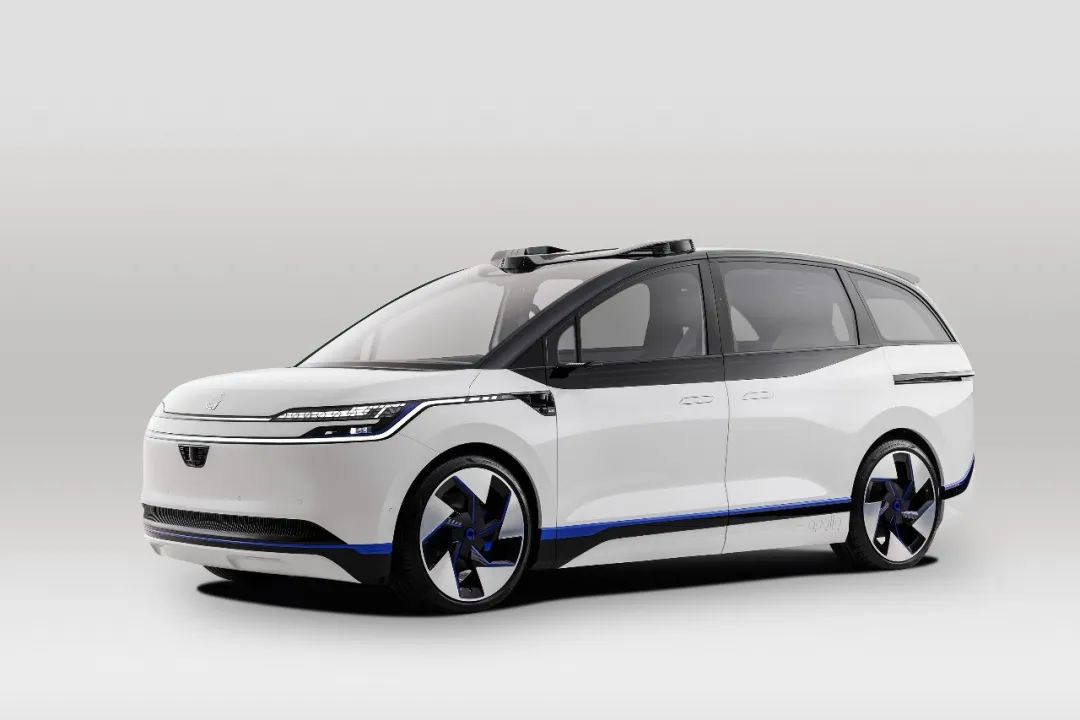
“This car’s appearance is becoming more and more like a conventional car. But its connotation is different. It is equipped with advanced autonomous driving technology and can be compared to an experienced driver with over 20 years of driving experience. Therefore, this car is not just a car, but also a good driver.” Li Zhenyu was very confident in describing Apollo RT6 to Sa Beining and the media attending the conference.

Upon reflection, the name Apollo RT6 resembles the acronym of the word “Robot.” This downplays the concept of “automobile robot,” which was somewhat vague, and emphasizes the advantage of Apollo RT6’s practical application. It also became another highlight of the conference.
Baidu Apollo’s Most Impressive Product to Date
Unlike previous generations of autonomous vehicles from Baidu, which relied heavily on modified models of existing vehicles and heavy cooperation with manufacturers, Apollo RT6 is designed to be a truly specialized, mass-produced model for Robotaxis.
Let’s take a look at the core information of Apollo RT6:
-
Product positioning: Baidu’s sixth generation mass-produced autonomous vehicle.
-
Vehicle size: Length 4760mm, width 1870mm, height 1650mm, wheelbase 2830mm.
-
Product price: Cost price of 2.5 million RMB.
-
Mass production time: It will be put into small-scale trial operation on the Wuling Hongguang MINI EV in the second half of 2023.
-
Deployment scale: The planned annual production capacity will gradually increase from tens of thousands to hundreds of thousands of units according to the deployment rhythm of operation. It is expected to operate in 65 cities in 2025 and cover 100 cities in 2030.
From “Star River”
Apollo Star River platform is a vehicle platform for autonomous driving. It is similar to the concept of traditional vehicle platforms of traditional automakers. However, the difference is that in addition to the relatively mature vehicle engineering-related parts, it also adds autonomous driving-related parts and system adaptation.

Therefore, the Apollo Star River platform is a platform that deeply integrates “vehicle engineering and autonomous driving technology.” RT6 is the first model developed based on the Apollo Star River platform.
RT6 is more positioned as an “autonomous driving crossover vehicle”, and it integrates the advantages of SUV and MPV models in terms of vehicle shape, structure, and space optimization. From the perspective of vehicle model alone, it can be understood as an enlarged version of the GAC AION Y or Hechuang Z03.

As a “dedicated mass-produced autonomous vehicle,” RT6 has made many optimization designs and adaptations for commercial operation scenarios, such as:

RT6’s skylight structure and roof sensor kit have been highly integrated into a unified design. On the premise of meeting the vehicle lighting demand, the layout of perception hardware has been optimized, and the integration with the vehicle body is higher. At the same time, based on the advantages of forward-looking design, it can provide a larger field of view for perception hardware.
 RT6 is equipped with an interactive light language design with recognition and prompts, integrated into the headlight and placed in a higher and easier-to-observe position on the roof. The interactive light language can provide prompts and feedback to other traffic participants.
RT6 is equipped with an interactive light language design with recognition and prompts, integrated into the headlight and placed in a higher and easier-to-observe position on the roof. The interactive light language can provide prompts and feedback to other traffic participants.

In the commercial operation scenario, RT6 adopts the commonly used electric sliding door design of MPV model to provide convenience for passengers to enter and exit.

Designed for “Autonomous Driving”
The most hardcore saying in the intelligent driving circle, “Don’t speak if you have less than 4”, has become a thing of the past.
RT6 is equipped with the latest generation of Apollo’s autonomous driving system, and the entire vehicle is equipped with 38 perception hardware, including 8 lidars, 6 millimeter wave radars, 12 ultrasonic radars, and 12 high-definition cameras.

128-line semi-solid-state lidars are used in RT6. Although Baidu has not explicitly stated the brand and model of the lidar, it is highly likely that the “Hesai AT128” used is the same as that of Jidu.
Among the eight lidars, 4 are integrated into the roof for 360-degree surround perception, and the other 4 are arranged on the body for blind spot compensation.

The four lidars on the roof will serve as the “main lidar” in the perception system, while the blind spot lidars arranged around the body will be responsible for supplementing the identification of emergency cut-in scenarios, low objects, and road static objects.

In addition to perception hardware, RT6 also has a “vehicle-level high-performance redundant dual computing unit” with a computing power of 1200 TOPS.
The entire vehicle hardware and autonomous driving suite components of RT6 meet the vehicle-level standards, and the entire vehicle redundancy is achieved at both hardware and software levels.
-
On the hardware level, there are seven-fold full-vehicle redundancy systems, including: architecture redundancy, sensor redundancy, computing unit redundancy, brake system redundancy, steering system redundancy, power supply redundancy, and dual 5G communication redundancy;
-
On the software level, it is equipped with a fault diagnosis and risk downgrade system for the entire vehicle and autonomous driving system.
百度 Apollo has developed a self-developed autonomous driving professional operating system, Apollo OS, which can achieve cross-platform architecture compatibility and reach car-level safety. At the same time, it provides middleware for computing and communication for the automotive architecture, accomplishing highly integrated and adapted software and hardware for vehicles. Apollo OS has achieved the industry’s first automated driving car-level safety ASIL D certification.

Regarding the RT6 as well as the latest generation of autonomous driving systems from Apollo, Li Zhenyu, Senior Vice President of Baidu Group, and General Manager of the Intelligent Driving Business Group, emphasized:
“Apollo RT6 is not only a car but also a good driver. Its built-in autonomous driving technology is equivalent to a driver with 20 years of experience.”
Since it is tailored for autonomous driving scenarios, in addition to the software and hardware of the autonomous driving system, RT6 is also equipped with wire-controlled chassis technology and more flexible and versatile cockpit space.

RT6 can switch between “manned/unmanned” mode, according to the needs to choose to deploy or retract the steering wheel.
Thanks to the advantages of pure electric vehicle models, and as a Robotaxi, RT6 does not need to consider the loading capacity of the trunk like an ordinary private car. As a tool for short and medium-distance travel, the RT6 has high space utilization.

Regarding the performance of the car’s interior space, Baidu Apollo defines it as A-sized car size (wheelbase 2830mm), B-sized car space (second-row legroom 1050mm), and C-sized car experience.
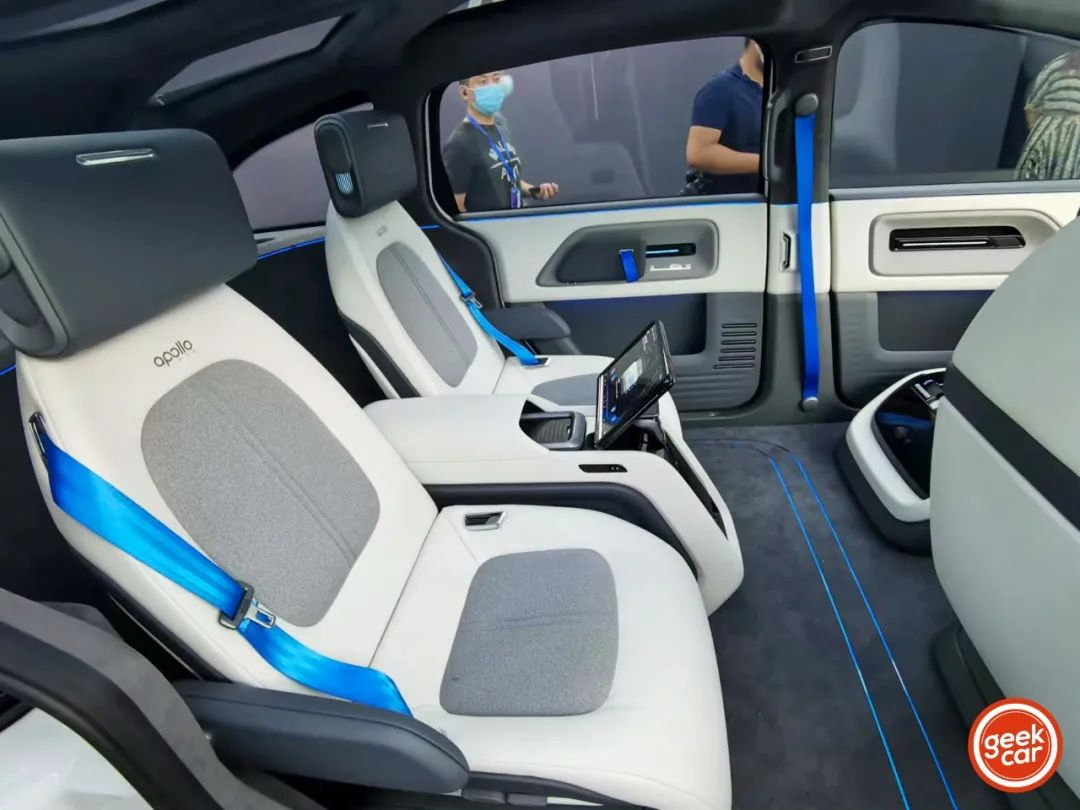
Moreover, the car’s interior space fully demonstrates Baidu’s understanding of the “era of autonomous driving.” The front row uses modular design and can be configured according to different travel scenarios, including: seats, vending machines, office desks, game consoles, etc., to meet different user demands for work and entertainment.

These features have become another extraordinarily distinctive feature of RT6 apart from its autonomous driving software and hardware.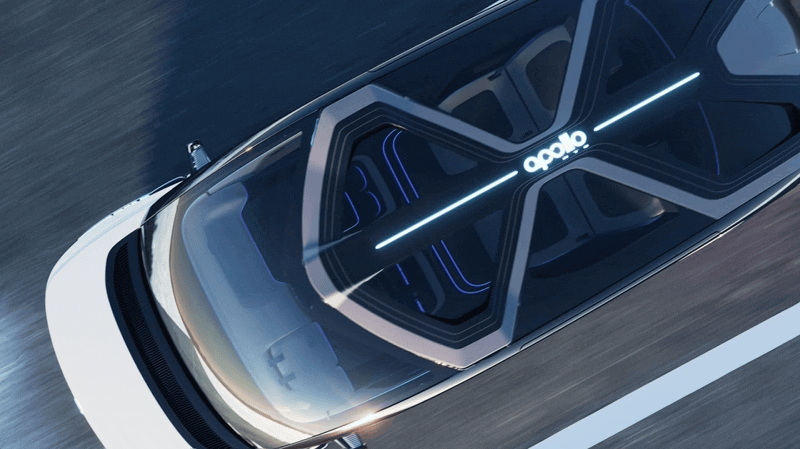
However, the design of RT6 is not unprecedented. Before that, Zhixing Box had released two models: BM-400 and BM-600.
Among them, the BM-400 adopts a “1+1+3” three-row five-seat layout in the car. The co-pilot seat is canceled, replaced by storage space for luggage and an automatic vending machine.

The second row also adopts a single-seat design, and the area near the sliding door is left empty, one is for the convenience of the third row passengers to get on and off, and the other is for the placement and fixation of wheelchairs of users with disabilities.

Among the three seats in the third row, a single seat is designed and called the “King’s seat”, which is a business seat with a leg rest and a 30° inclination angle.

On the other side of the earth, Canoo, an electric car start-up company located in Los Angeles, USA, has also launched their first electric car product, the Canoo EV.


Although these cars have some differences in planning from Baidu Apollo’s “self-research, self-production, and self-use”, they have all abandoned the traditional seat layout and planned for more travel methods and travel scenarios.

This cabin concept change is likely to be gradually realized starting from Robotaxi. In the near future, more private car models will continue this trend.
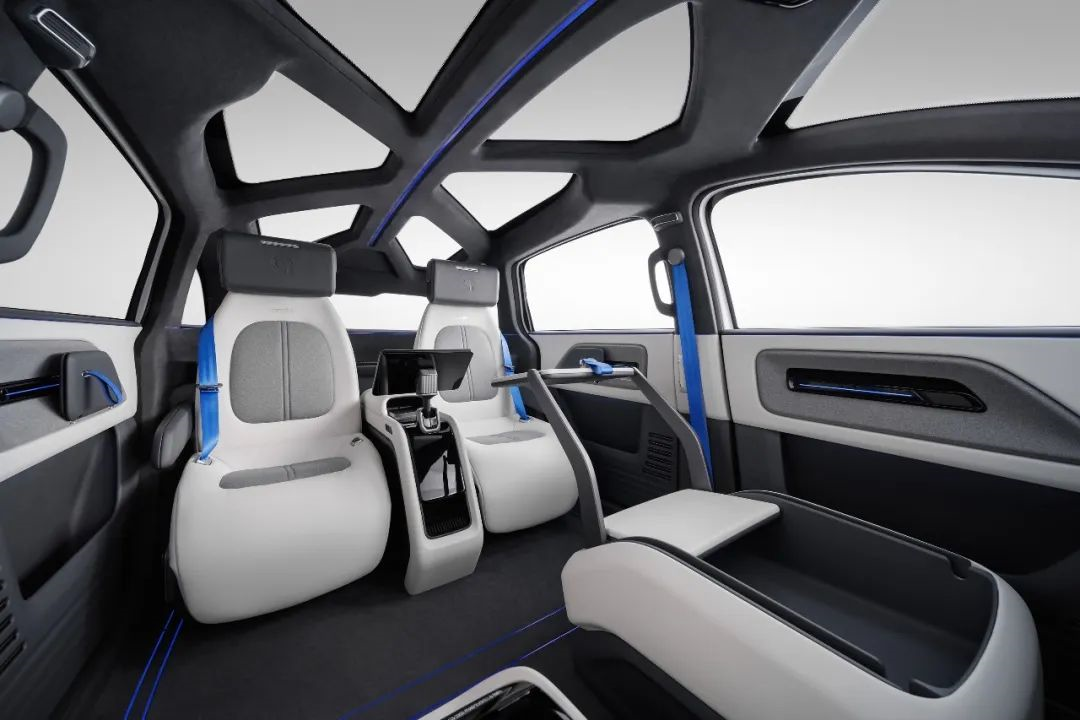 ## Safety, Safety, and More Safety!
## Safety, Safety, and More Safety!
Whether it’s a regular passenger car or a robotaxi, safety always comes first.
At the “basic safety level” of a car, the RT6 adopts a super-high-strength cage-like body design and a “rear-enhanced safety protection for backseat passengers” design.

In terms of the safety of autonomous driving, the RT6 mainly relies on a three-layer safety system of single-vehicle intelligence, monitoring redundancy, and parallel driving to ensure driving safety.
On the single-vehicle intelligence side, the real-time car-based basic OS is the main system, which includes a perception system containing map, location, and environmental awareness, decision-making and planning system, and a vehicle-road cooperative system. These systems work together to create a safe design for the autonomous driving system.

At the same time, in the face of different risk levels, the RT6 will use fully redundant autonomous driving hardware as the basis and combine it with monitoring systems to achieve a perfect risk downgrade strategy. For example, the vehicle can be controlled safely through methods like slowing down, stopping, and pulling over to the roadside, thereby avoiding collision risks.
In addition, the RT6 is equipped with “parallel driving” function. Based on 5G communication technology, the RT6 can achieve “remote real-time vehicle control.” The remote cockpit can rebuild the current driving environment of the vehicle, and the cloud-based security personnel can clearly understand the driving and environmental conditions of the vehicle and intervene remotely when necessary, achieving real-time remote vehicle control.
The “Positive Thinking” of the New Era
To create an unmanned vehicle that meets requirements and positioning, AI technology and vehicle engineering must be deeply integrated. Independent research, production, and use can better control safety, quality, and cost.
However, the current industry’s approach, which is based on the modification or installation of automatic driving kits for a mass-produced vehicle, falls far short of these standards and requirements. This is also the biggest difference between the RT6 and modified automatic driving vehicles on the market.

Meanwhile, the RT6’s ability to meet 100% vehicle regulations and vehicle redundancy is based on the premise of a forward-looking design and adaptation of the entire vehicle. Moreover, with the promotion of the autonomous driving trend, moving from custom modification and installation based on a finished vehicle to platform-based customization and development will ultimately become the major trend for unmanned vehicle development.Unlike many automakers in the present era, more and more automakers are developing intelligent hardware and software, including chips, in-vehicle operating systems, and intelligent driving systems, based on the research and development of vehicle models to meet the requirements of intelligent functions.
In contrast, Baidu Apollo is not an automaker, but an autonomous driving company or a provider of intelligent driving systems. Apollo aims to build a truly suitable car for autonomous driving, contributing to the birth of RT6, which represents a “new era of positive thinking.”
Building software and hardware in-house can also reduce costs. For regular taxis and ride-hailing services, costs generally consist of driver expenses, vehicle depreciation, and daily operating costs such as fuel, charging, maintenance, cleaning, and insurance. The cost of autonomous vehicles must be lower than that of ride-hailing services, involving both reduced driver expenses through autonomous driving and lower vehicle costs for widespread vehicle deployment.
RT6 has greatly contributed to the cost reduction of the entire Baidu Robotaxi operating system in three ways:
- Reduced whole-vehicle cost: RT6 is customized for Robotaxi operating scenarios by removing hardware, functions, and designs that are unnecessary for operating scenarios. Additionally, RT6 is based on the Baidu’s proprietary platform, which also greatly reduces the cost of the vehicle itself.
- Lower cost of autonomous driving kit: technological advances and the widespread use of sensors and computing units significantly lower the cost of autonomous driving kits used in RT6.
- China’s manufacturing advantages: a mature and complete supply chain and production process that further lowers costs.
Baidu Apollo has run the numbers:
Based on a five-year operation cycle and assuming a first-tier city, the monthly cost for ride-hailing drivers is around CNY 8,000 (excluding vehicle costs). As Apollo RT6’s biggest advantage is no drivers, the cost of each car is only about CNY 4,100 per month. As operating costs decrease, the corresponding user costs will also decrease.At present, the purchase cost of most ride-hailing and taxi (electric vehicle) vehicles is around CNY 100,000. If the cost of autonomous vehicles cannot be controlled within CNY 400,000, it will be difficult to compete with the cost of drivers. This also includes the data and maintenance costs of autonomous vehicles.
Therefore, RT6 has managed to control the overall vehicle cost at CNY 250,000, which is still more than double the purchase cost of ride-hailing and taxi vehicles.
However, in the long run, taking 5 years driving 600,000 kilometers as an example, the depreciation of the vehicle costing CNY 250,000 is approximately CNY 50,000 per year, equivalent to a daily depreciation of about CNY 140 when factoring in renewable energy, data, and other costs. If the revenue per order is CNY 20, a daily order volume of 10-20 orders can cover the cost.
Baidu’s autonomous driving is already on the road
Including the first-generation autonomous cars, Baidu has now released a total of seven autonomous shared vehicles. During this period, Baidu Apollo’s autonomous driving capabilities have been widely verified, and currently, Baidu Apollo’s autonomous driving test mileage has exceeded 32 million kilometers.
At this moment, the predecessors of RT6 are quietly standing in front of a wall in Apollo Park, located in the Beijing Economic-Technological Development Area.

Rewind one year. At the 2021 Baidu World Conference, Baidu released the “Luobo Kuai Pao” platform.
In the past year, Luobo Kuai Pao has been running on the roads of more than ten cities including Beijing, Shanghai, Shenzhen, Guangzhou, Chongqing, Wuhan, and has accumulated more than one million orders.
According to Li Zhenyu, from this number of one million, Baidu has become the world’s largest autonomous driving travel service provider. Li Zhenyu gave an example:
In the first year of operation of Luobo Kuai Pao, the order volume of many users has exceeded hundreds of orders, and even a young male user has ordered more than 600 times.
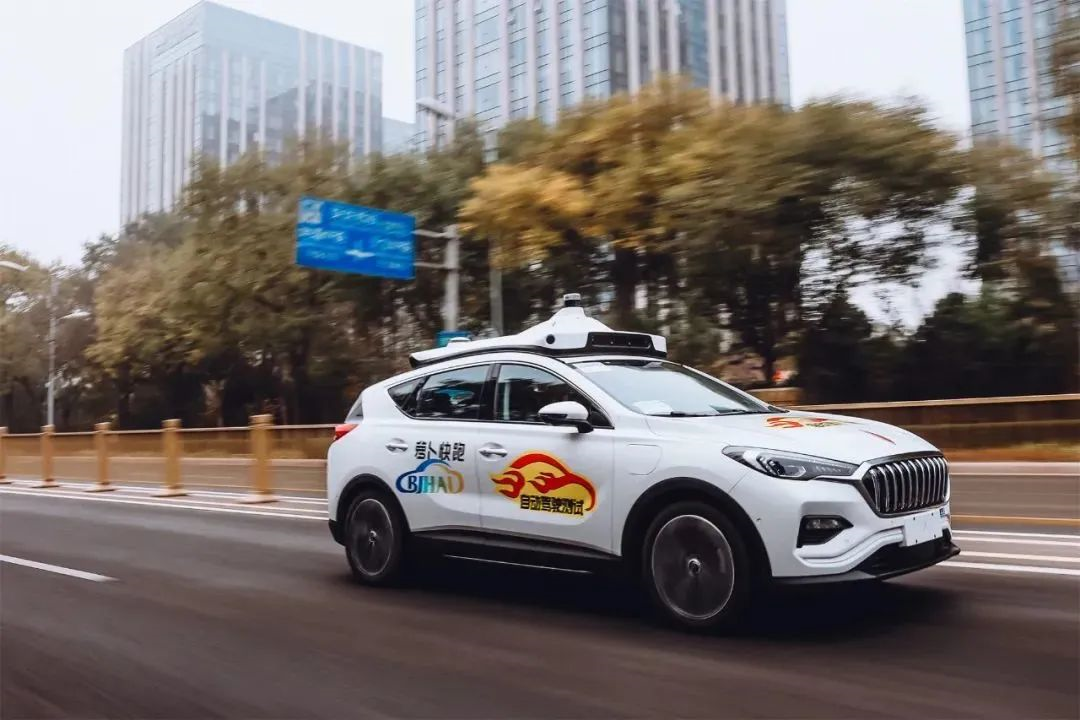
Let’s do some simple math. If we subtract the statutory holidays and calculate it based on about 250 working days a year, this number has probably already covered the daily commuting scenario of the user.
“You should give him six free rides,” Sa Beining interrupted Li Zhenyu.
In April of this year, Baidu obtained a license for the operation of driverless vehicles in Yizhuang. While most people were unaware, Robotaxi has already officially launched its commercial operation.
On July 20, yesterday, Beijing officially opened the country’s first commercial pilot for unmanned travel services. Baidu and Pony.ai, among the first enterprises to receive licenses, will deploy 30 self-driving vehicles in the core area of the Economic Development Zone, covering an area of 60 square kilometers, to provide charged services regularly.

According to a relevant person in charge of the Beijing Autonomous Driving Office, in terms of admission mechanism, the “Administrative Implementation Rules (Trial) for the Pilot Management of Commercialized Automated Driving Travel Services in the Beijing Intelligent Networked Car Policy First Pilot Zone” issued previously made specific requirements for the number of entity mileage, orders received, vehicles, takeover quantity, and new vehicle test mileage of the applicant.
For example, regarding the number of orders received by the applicant entity, the “Implementation Rules” require that during the commercial pilot phase of human-driven vehicles, the number of orders received should be not less than 20,000; during the demonstration application phase of privately-driven vehicles without a steering wheel, the number of orders received should be not less than 1,000.

As we all know, Baidu has always been the fastest to follow policy changes in the industry.
According to Baidu’s plan, they will put a small batch of vehicles into trial operation on the robo-taxi platform, Luobo Kuai Pao, in the second half of 2023. The planned annual capacity will gradually increase from ten thousand units to one hundred thousand units based on the deployment rhythm of the operation. By 2025, it is predicted that Luobo Kuai Pao will operate in a total of 65 cities across the country, and it will cover 100 cities by 2030.
Everything seems to be getting more promising now.
The End
As I come to the end of this article, I suddenly want to end on a romantic note.
GeekCar’s Wang Tupu once asked me what the intelligent cockpit of the future would look like.
At the time, I said, “Don’t think too wildly. After autonomous driving is truly realized, there may be nothing inside the cabin. The functions and designs that serve passengers may all be realized through modularization, and even customization.”
 As a heavy user of ride-hailing as a DiDi member approaching full level, today’s release undoubtedly brings good news to me.
As a heavy user of ride-hailing as a DiDi member approaching full level, today’s release undoubtedly brings good news to me.
Design, technology, cost, operation, and so on, these words have nothing to do with me as a passenger.
What I need is a safe journey, without worrying about whether I can confirm the payment on the travel APP with my own will when getting off.
What I need is a smooth journey, without affecting the experience of every ride because of the driver/master’s physical and mental state.
What I need is undisturbed personal time, and I won’t be accompanied by the net car driver’s loud TikTok playback like the more than 30 kilometers of the round trip when attending a meeting today.
What I need is a reasonable travel expense, without the blood pressure rising along with the taxi meter’s numbers during every peak period.
What I want is a good and stable experience. I hope that every ride can be as satisfying as the last one.

Today, at the venue of Building 5 of Baidu Technology Park, I seemed to see the outline of that possibility.
This article is a translation by ChatGPT of a Chinese report from 42HOW. If you have any questions about it, please email bd@42how.com.
